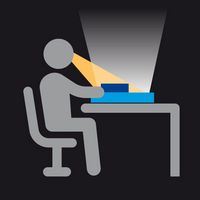
In addition to vision solutions, it is inevitable that test parts will need to be visually inspected and evaluated by operators.
For this area of visual inspection, our LED lights are specially designed to meet the requirements of backlight or transmitted light inspection by humans.

Our Color Control product group includes backlights with a color rendering of approximately Ri97. This ensures good color assessment at all times. The lights can be dimmed with the external dimmer module to adjust the brightness to the test task and the environment.
The housings are manufactured to industry standards and feature an anti-glare surface. This means that the operator is not distracted by reflections from the environment and can concentrate fully on the inspection task.
Even though color fastness is not a factor in the tests, the employee's eye perceives the high-quality standard light as very pleasant because the typical blue tint of "standard LEDs" is absent. The sun-like light is therefore less tiring.
We have based the development of the lamp on the following standards:

This is precisely where our strength lies. Because planistar manufactures the lights in-house, we can produce customised backlighting with short delivery times.
So you don't have to follow our standard programme. We adapt exactly to your requirements and the conditions on site.
This saves you costs in theOur production processes are planned in such a way that a customised light has almost the same throughput as a standard light. The only difference is that the customised luminaire is precisely documented. This means that we are able to supply replacements even years later.
Benefit from the co-operation with planistar.
Lights direct from the manufacturer
We always take sustainability into account when revising our product ranges, because many small things add up to a big picture.
This starts with resource and energy conservation, the right choice of materials we use, through to packaging and disposal.
There are basically three types of backlight inspection. First, translucent materials are X-rayed. In addition, contours or outlines of test parts are inspected. A combination of backlighting and oblique light is also used to inspect mostly shiny materials.
Translucent materials are illuminated with a customized light source. The goal is to detect:
The brightness and color of the light must be adjusted to match the specimen. The features to be detected must not be illuminated too brightly (overexposure) or too darkly.
The contours of the specimen are backlit with special test lights. The task is to test:
Again, the light should not be too bright or the edges will be washed out. The features will not be visible.
Typical inspection task of a reflective specimen evaluation
The light is positioned opposite the observer (mixture of backlighting and incident light viewing) and is reflected in the object. This creates a good contrast to the features to be recognized. These include
The lamp must be the right size, otherwise the reflection and therefore the test area will be too small, especially for difficult specimens to test. The right brightness is also important. A dimmable version is recommended.
When inspecting glossy surfaces, we are able to print stripe structures on the luminous surface. This makes it possible to detect the finest unevenness. The type of print (stripe, grid, size) can be customized.
There are several criteria to consider when choosing the right luminaire for a transmitted light inspection. Here are the most important ones.
You often hear "it can't be bright enough". This is not always true. Depending on the part to be inspected, the feature to be detected, and the inspection environment, the light must not be too dark, but also not too bright.
The goal is to find the “golden mean”
The examiner also plays an important role. Ideal brightness may vary depending on age or perception of brightness. We always recommend a dimmable version.
The correct light color of the test light is important. Typically, a neutral white of about 5000-6000 K is chosen. This is most similar to sunlight (neutral white). Our eyes are used to this light color and people react neutrally to it. If the light color is too warm, the tester may experience premature fatigue. A light color that is too cold also has an unfamiliar or disturbing effect.
The general light color in the room should also be a neutral white. This means that the eye does not have to change direction when looking from the test luminaire to the room.
In addition to light color, the light quality of the light source is also important. The Ra value indicates the composition of the light spectrum of the LED. In general, only the Ra value is used. For LEDs, however, the Ri value (extended Ra value) should be specified. This includes the strong primary colors. planistar always specifies both values.
The inspection light is often too small (not much larger than the part to be inspected). However, the small field of view is a disadvantage for the inspector. Since the operator's actual field of view is larger, he or she must adjust his or her eyes to the contrast between the illuminated area and the darker surroundings at the slightest change in viewing direction. This has a negative effect on concentration and promotes fatigue.
Important: The luminaire can never be too large, but it can quickly become too small.
Our team will be at your disposal for any questions you may have. We will process your request as soon as possible.
| +49 (0) 9364 8060-0 | sales@no-spam.planistar.de | Catalog incl. prices | |||||||
|